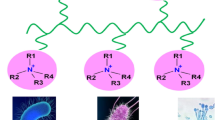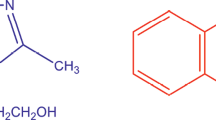Abstract
Different fluoroquinolon-type antibiotics were conjugated to gelatin with the aim to synthesize biomacromolecules with antimicrobial properties. The covalent linkage of the antibiotic was performed by a radical process involving the residues in the side chains of gelatin able to undergo oxidative modifications. The conjugation of antibiotic moieties onto the protein structure was confirmed by FT-IR, UV–Vis, fluorescence, and calorimetric analyses. Biocompatibility tests were performed on human bone marrow mesenchymal stromal cells and the antibacterial properties of bioactive polymers were investigated by appropriate tests against Klebsiella pneumoniae and Escherichia coli. With regard to the tests conducted in the presence of E. coli, a minimum inhibitory concentration (MIC) ranging from 0.05 to 0.40 μg mL−1 was recorded, while in the presence of K. pneumoniae this concentration varies from 0.10 to 1.60 μg mL−1. In all the conjugates, the drug moieties retain their biological activity and the MIC values are lower than the resistance parameters of fluoroquinolon-type antibiotics versus Enterobacteriacae. The collected data suggest a broad range of applications, from biomedical to pharmaceutical and food science for all conjugates.








Similar content being viewed by others
References
Rutala WA, Weber DJ. Disinfection and sterilization in health care facilities: what clinicians need to know. Clin Infect Dis. 2004;39:702–9.
Lv W, Luo J, Deng Y, Sun YJ. Biomaterials immobilized with chitosan for rechargeable antimicrobial drug delivery. J Biomed Mat Res A. 2013;101A:447–55.
Vasilev K, Griesser SS, Griesser HJ. Antibacterial surfaces and coatings produced by plasma techniques. Plasma Proc Polym. 2011;8:1010–23.
Caleb OJ, Mahajan PV, Al-Said FAJ, Opara UL. Modified atmosphere packaging technology of fresh and fresh-cut produce and the microbial consequences-A Review. Food Bioproc Technol. 2013;6:303–29.
Pollini M, Paladini F, Catalano M, Taurino A, Licciulli A, Maffezzoli A, Sannino A. Antibacterial coatings on haemodialysis catheters by photochemical deposition of silver nanoparticles. J Mater Sci Mater Med. 2011;22:2005–12.
Rahman MM, Pervez S, Nesa B, Khan MA. Preparation and characterization of porous scaffold composite films by blending chitosan and gelatin solutions for skin tissue engineering. Polym Int. 2013;62:79–86.
Garg T, Singh O, Arora S, Murthy RSR. Scaffold: a novel carrier for cell and drug delivery. Crit Rev Ther Drug Carrier Syst. 2012;29:1–63.
Scaffaro R, Botta L, Sanfilippo M, Gallo G, Palazzolo G, Puglia AM. Combining in the melt physical and biological properties of poly(caprolactone) and chlorhexidine to obtain antimicrobial surgical monofilaments. Appl Microbiol Biotechnol. 2013;97:99–109.
Bastarrachea L, Dhawan S, Sablani SS. Engineering properties of polymeric-based antimicrobial films for food packaging. Food Eng Rev. 2011;3:79–93.
Simchi A, Tamjid E, Pishbin F, Boccaccini AR. Recent progress in inorganic and composite coatings with bactericidal capability for orthopaedic applications. Nanomed Nanotechnol Biol Med. 2011;7:2–39.
Banerjee I, Pangule RC, Kane RS. Antifouling coatings: recent developments in the design of surfaces that prevent fouling by proteins, bacteria, and marine organisms. Adv Mat. 2011;23:690–718.
Muñoz-Bonilla A, Fernández-García M. Polymeric materials with antimicrobial activity. Progr Polym Sci. 2012;37:281–339.
Blecher K, Nasir A, Friedman A. The growing role of nanotechnology in combating infectious disease. Virulence. 2011;2:395–401.
Gomathi N, Sureshkumar A, Neogi S. RF plasma-treated polymers for biomedical applications. Curr Sci. 2008;94:1478–86.
Zahedi P, Rezaeian I, Jafari SH. In vitro and in vivo evaluations of phenytoin sodium-loaded electrospun PVA, PCL, and their hybrid nanofibrous mats for use as active wound dressings. J Mater Sci. 2013;48:3147–59.
Glinel K, Jonas AM, Jouenne T, Leprince J, Galas L, Huck WTS. Antibacterial and antifouling polymer brushes incorporating antimicrobial peptide. Bioconjug Chem. 2009;20:71–7.
Barnes K, Liang J, Worley SD, Lee J, Brouughton RM, Huang TS. Modification of silica gel, cellulose, and polyurethane with a sterically hindered N-halamine moiety to produce antimicrobial activity. J Appl Polym Sci. 2007;105:2306–13.
Kriegel C, Arrechi A, Kit K, McClement DJ, Weiss J. Fabrication, functionalization, and application of electrospun biopolymer nanofibers. Crit Rev Food Sci Nutr. 2008;48:775–97.
Djagny KB, Wang Z, Xu S. Gelatin: a valuable protein for food and pharmaceutical industries: review. Crit Rev Food Sci Nutr. 2001;41:481–92.
Gómez-Guillén MC, Giménez B, López-Caballero ME, Montero MP. Functional and bioactive properties of collagen and gelatin from alternative sources: a review. Food Hydrocoll. 2011;25:1813–27.
Young S, Wong M, Tabata Y, Mikos AG. Gelatin as a delivery vehicle for the controlled release of bioactive molecules. J Controlled Release. 2005;109:256–74.
Palsson BO, Bhatia SN. Tissue Engineering. 1st ed. New Jersey: Pearson Prentice Hall; 2004.
Park SN, Park JC, Kim HO, Song MJ, Suh H. Characterization of porous collagen/hyaluronic acid scaffold modified by 1-ethyl-3-(3-dimethylaminopropyl) carbodiimide cross-linking. Biomaterials. 2002;23:1205–12.
Eastoe JE. The amino acid composition of mammalian collagen and gelatin. Biochem J. 1955;61:589–600.
Fernandes FM, Manjubala I, Ruiz-Hitzky E. Gelatin renaturation and the interfacial role of fillers in bionanocomposites. Phys Chem Chem Phys. 2011;13:4901–10.
Peña C, de la Caba K, Eceiza A, Ruseckaite R, Mondragon I. Enhancing water repellence and mechanical properties of gelatin films by tannin addition. Biores Technol. 2010;101:993–1011.
Lai J-Y. Biocompatibility of chemically cross-linked gelatin hydrogels for ophthalmic use. J Mater Sci Mater Med. 2010;21:1899–901.
Law B, Tung C-H. Proteolysis: a biological process adapted in drug delivery, therapy, and imaging. Biocon Chem. 2009;20:1683–95.
Spizzirri UG, Parisi OI, Iemma F, Cirillo G, Puoci F, Curcio M, Picci N. Antioxidant-polysaccharide conjugates for food application by eco-friendly grafting procedure. Carbohydr Polym. 2010;79:333–40.
Iemma F, Puoci F, Curcio M, Parisi OI, Cirillo G, Spizzirri UG, Picci N. Ferulic acid as a comonomer in the synthesis of a novel polymeric chain with biological properties. J Appl Polym Sci. 2010;115:784–9.
Spizzirri UG, Iemma F, Puoci F, Cirillo G, Curcio M, Parisi OI, Picci N. Synthesis of antioxidant polymers by grafting of gallic acid and catechin on gelatin. Biomacromolecules. 2009;10:1923–30.
Cirillo G, Vittorio O, Hampel S, Spizzirri UG, Picci N, Iemma F. Incorporation of carbon nanotubes into a gelatin–catechin conjugate: innovative approach for the preparation of anticancer materials. Int J Pharm. 2013;446:176–82.
Dalhoff A. Global fluoroquinolone resistance epidemiology and implictions for clinical use. Interdiscip Perspect Infect Dis. 2012;2012:976273.
Kaye KS, Auwaerter P, Bosso JA, Dean NC, Doern GV, Kays MB, Pogue JM, Ritchie DJ, Wispelwey B. Strategies to address appropriate fluoroquinolone use in the hospital. Hosp Pharm. 2010;45:844–53.
Namboodiri SS, Opintan JA, Lijek RS, Newman MJ, Okeke IN. Quinolone resistance in Escherichia coli from Accra, Ghana. BMC Microbiol. 2011;11:44.
Wu SS, Chein CY, Wen YHJ. Analysis of ciprofloxacin by a simple high-performance liquid chromatography method. Chromatogr Sci. 2008;46:490–5.
Tozo GCG, Salgado HRN. Determination of lomefloxacin in tablet preparations by liquid chromatography. J AOAC Int. 2006;89:1305–8.
Gao XX, Yao GC, Guo N, An F, Guo XJ. A simple and rapid high performance liquid chromatography method to determine levofloxacin in human plasma and its use in a bioequivalence study. Drug Discov Ther. 2007;1:136–40.
Vittorio O, Cirillo G, Iemma F, Di Turi G, Jacchetti E, Curcio M, Barbuti S, Funel N, Parisi OI, Puoci F, Picci N. Dextran-catechin conjugate: a potential treatment against the pancreatic ductal adenocarcinoma. Pharm Res. 2012;29:2601–14.
Santoke H, Song W, Cooper WJ, Greaves J, Miller GE. Free-radical-induced oxidative and reductive degradation of fluoroquinolone pharmaceuticals: kinetic studies and degradation mechanism. J Phys Chem A. 2009;113:7846–51.
Johnson JR, Gajewski A, Lesse AJ, Russo TA. Extraintestinal pathogenic escherichia coli as a cause of invasive nonurinary infections. J Clin Microbiol. 2003;41:5798–802.
Bousquet A, Malfuson J-V, Sanmartin N, Konopacki J, Macnab C, Souleau B, de Revel T, Elouennass M, Samson T, Soler C, Foissaud V, Martinaud C. An 8-year survey of strains identified in blood cultures in a clinical haematology unit. Clin Microbiol Infection. 2013;. doi:10.1111/1469-0691.12294.
Karageorgopoulos DE, Maraki S, Vatopoulos AC, Samonis G, Schito GC, Falagas ME. Antimicrobial activity of prulifloxacin in comparison with other fluoroquinolones against community-acquired urinary and respiratory pathogens isolated in Greece. Eur J Clin Microbiol Infect Dis. 2013;. doi:10.1007/s10096-013-1891-z.
Di Paolo A, Gori G, Tascini C, Danesi R, Del Tacca M. Clinical pharmacokinetics of antibacterials in cerebrospinal fluid. Clin Pharmacokinet. 2013;52:511–42.
Pitout JDD. Extraintestinal pathogenic Escherichia coli: an update on antimicrobial resistance, laboratory diagnosis and treatment. Exp Rev Anti-Infect Ther. 2012;10:1165–76.
Jiang D, Liu Y, Zhan Q. Etiological analysis of 216 cases of hospital-acquired infections in neurology intensive care unit. Chin J Infect Chemother. 2013;13:35–9.
Chen Y-H, Hsueh P-R. Changing bacteriology of abdominal and surgical sepsis. Curr Op Infect Dis. 2012;25:590–5.
The European Committee on Antimicrobial Susceptibility Testing. Breakpoint tables for interpretation of MICs and zone diameters. Version 3.1, 2013. http://www.eucast.org.
National Committee for Clinical Laboratory Standards. Methods for dilution antimicrobial susceptibility tests for bacteria that grow aerobically. Approved standard M7-A3. 1993.
Acknowledgments
This work was supported by University of Calabria funds. Financial support of Regional Operative Program (ROP) Calabria ESF 2007/2013—IV Axis Human Capital—Operative Objective M2—Action D.5 is also gratefully acknowledged.
Author information
Authors and Affiliations
Corresponding author
Rights and permissions
About this article
Cite this article
Cirillo, G., Mauro, M.V., Spizzirri, U.G. et al. Synthesis, characterization and antimicrobial activity of conjugates based on fluoroquinolon-type antibiotics and gelatin. J Mater Sci: Mater Med 25, 67–77 (2014). https://doi.org/10.1007/s10856-013-5053-8
Received:
Accepted:
Published:
Issue Date:
DOI: https://doi.org/10.1007/s10856-013-5053-8




